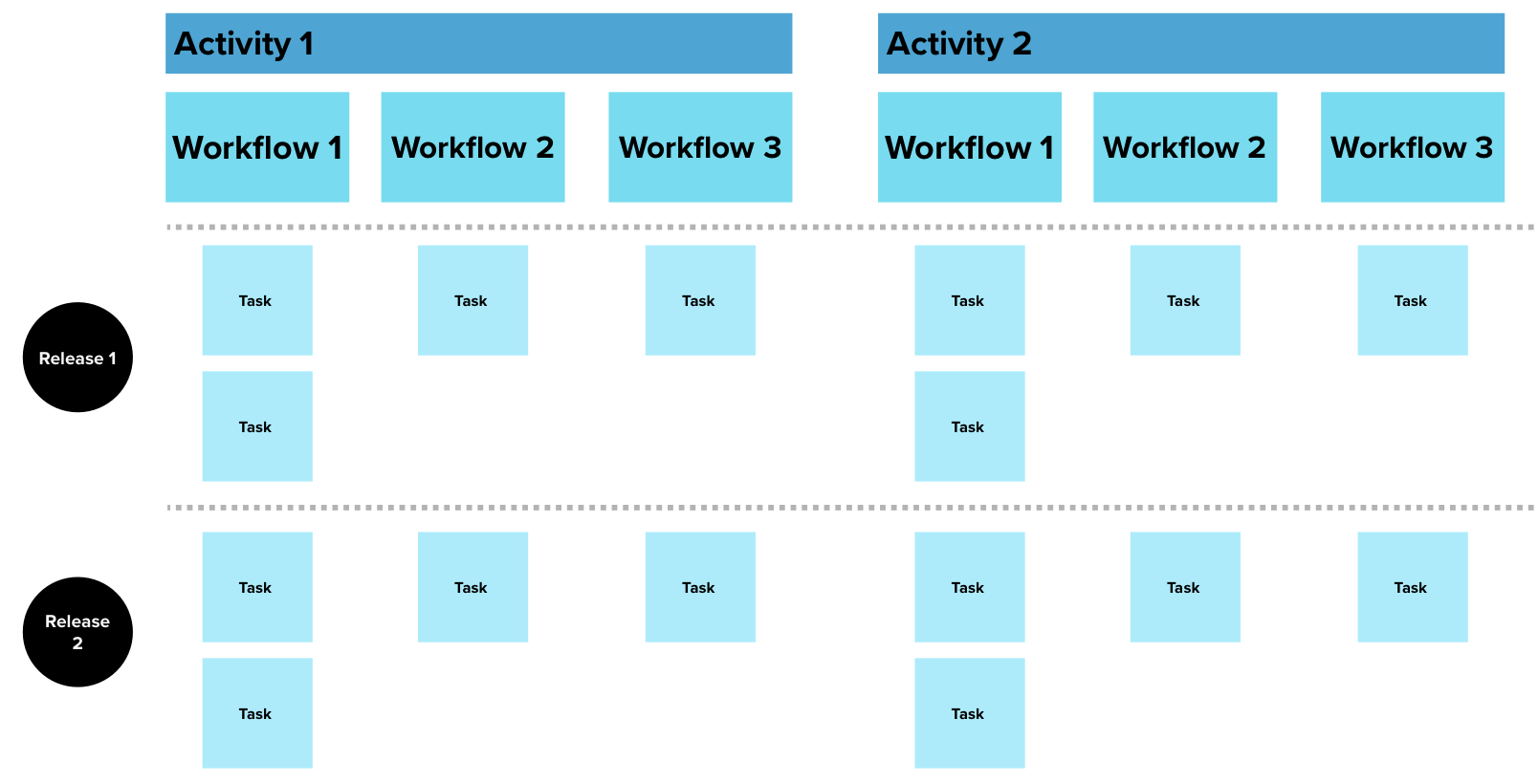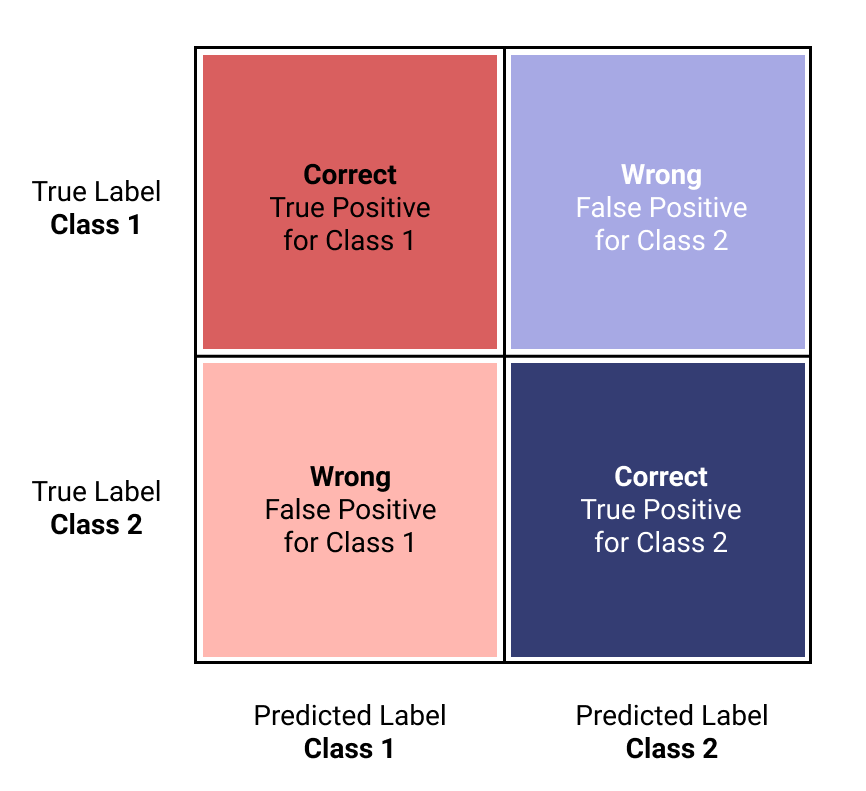How Might We Utilize Design Thinking to Boost Data Science Projects
What is Design Thinking?
First, you might think, "What does design thinking have to do with Data Science?!" Let's start with a definition of Design Thinking, and then see how everyone can apply Design Thinking Methods to Data Science.
One of the early pioneers of Design Thinking, IDEO, they define Design Thinking as:
Design thinking is a human-centered approach to innovation that draws from the designer’s toolkit to integrate the needs of people, the possibilities of technology, and the requirements for business success.
A few things jump out. First is that it's a human-centered approach, which means that you're designing solutions in the service of people, not technology. Every Data Scientist and Analyst should be thinking about the user first! Second, it takes designers' tools and applies them to generalized business success. Design Thinking isn't just for designers, and it certainly isn't just for software User Interfaces (UI)!
As a Data Scientist, there are numerous ways that you can incorporate Design Thinking into your work to help solve problems, such as:
- Stakeholder Management
- Identifying the Most Important Problem to Solve
- Prioritizing Work
- Getting Thoughtful Critique
- Determining the Usability of Your Solution
- Build a Launch Plan, Before You Build
Before jumping in, let's look at a few fundamentals of Design Thinking.
The Double Diamond
I first want to talk about the concept of the Double Diamond. The Double Diamond is a core concept in design thinking and helps you frame how to think about approaching a problem and developing a solution. The concept is that you start from the left and do two sets of divergent and convergent exercises that help you identify the problem to solve and then explore a broad space around the solution, finally coming up with the solution. Two words you will hear a lot in design thinking are divergent and convergent.
- Divergent: Opening your mind to a broad range of possibilities. As my friend and mentor say when starting a session:
"it's easier to tame a wild idea than to amplify a weak one.
- Convergent: Narrowing down the range of possibilities to a singular one.
The Double Diamond and divergent and convergent thinking are applied to different design thinking methods to help develop the solution.
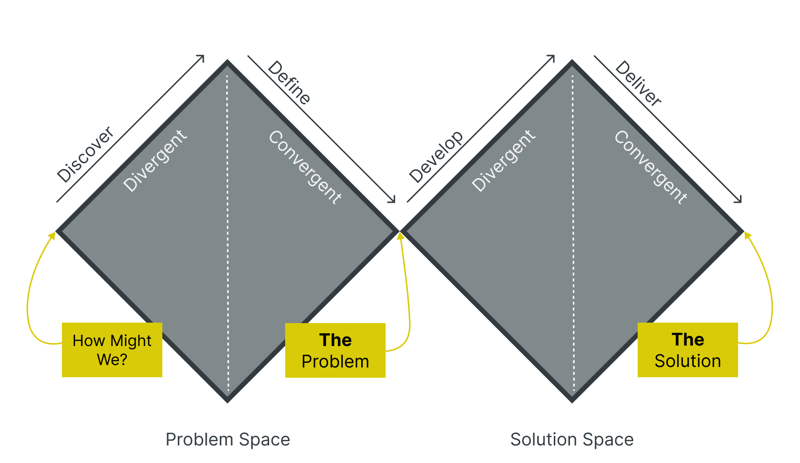
How Might We
You may have heard this phrase before, How Might We, which is often abbreviated to HMW. These three powerful words help us frame a problem statement in a powerful, inclusive way.
- How: suggests that we don't yet know the solution.
- Might: suggests that a solution is possible and there could be several ways to implement it.
- We: bring everyone together to help solve the problem.
You'll see this quite a bit when practicing Design Thinking, and I suggest you try it yourself and see how it invites collaboration to help open up your problem statement to new perspectives. Let's take a look at a quick example:
from
Build a recommender system for streaming music
to
How might we queue up music that will delight users so that they listen for hours?
Notice the difference? Much more inspiring and also brings the user into the problem.
Design Thinking Methods
There are many different design thinking methods that you can utilize, and they're probably hundreds or even thousands of them. Different organizations have curated "systems" of design thinking methods and selected ones for you, such as IDEO's Design Kit, Google Design Sprints, or the set I'm certified in, the LUMA Institute's Methods.
Here is a full list of the LUMA methods from their website. We'll cover several of these in this post, but in reality, every one of these can apply at some point in time to Data Science. Each method is documented on their website if you want to learn more.

Let's get started!
Design Thinking Tools
The core set of tools for design thinking is typically Post-It Notes, Sharpies, Voting Dots, and Easel Pads. These incredibly simple items can help you run sessions in a room that produces amazing outcomes.
Over the past few years, one of the amazing things has been the proliferation of digital tools that help facilitate virtual design thinking sessions. Tools such as MURAL, Miro, Google Jamboard, and FigJam from Figma are all great tools that help. Each has a free option to get you started on your journey.
My tool of Choice is MURAL. I often use it as a personal productivity tool as well.
Some of these are even loaded with templates that get you started faster.

Stakeholder Management
When starting a project, you want to consider who your users or stakeholders are. Your stakeholders could be internal members of sales, service, or engineering, or they could be executives or external customers. Each of these stakeholders has a different set of needs and wants; this is where Stakeholder Management comes in.
The first method I like to do before starting a new project is to run a Stakeholder Mapping exercise; A great exercise to do with your team if you can. It helps build a shared understanding of who the most important people are. I like to start with a tree-like structure with the most important people at the top and build from there. Then map each player based on their level of involvement in the project.
After identifying all the key people, you can map them to a simple two-by-two matrix with Influence and Interest/Availability as your axis. Using these quadrants, you can determine your engagement model for them, such as Keep Satisfied, Actively Engage, Keep Informed, and Monitor. A simple model to keep your structured in your engagement.
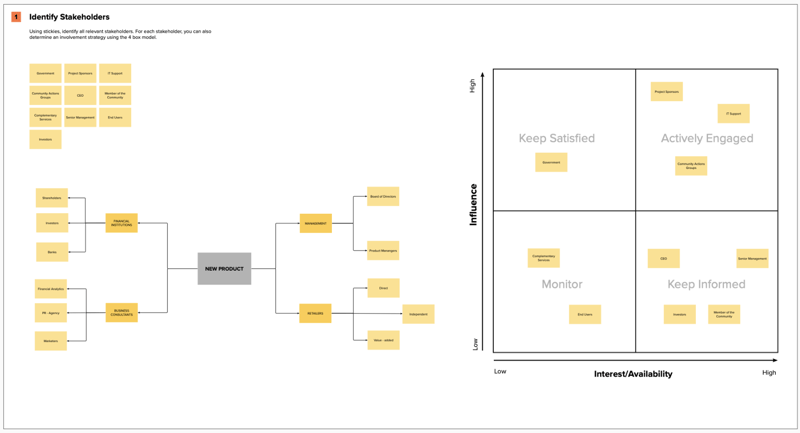
Next, based on my stakeholder map, I like to think about my Interviewing strategy. Who will I talk to ensure I understand my customer's needs properly. Interviewing is a simple process, but there are a few best practices:
- Ensure you have the person's consent if you're recording the interview for later use.
- Ensure that you have a consistent set of questions to compare across interviewees. Start with simple questions, and then get more specific as you go.
- Ensure you're a good listener, not leading the person to the answer you want.
Identifying the Most Important Problem to Solve
As you start a project, you must ensure you're solving the right problem. We started with identifying and interviewing our stakeholders, but how do we pull out the most important problem? A great way to determine what is most critical to work on is to get your stakeholders together for a facilitated session and have them generate ideas in real-time. Two that I utilize frequently are the combination of a divergent activity called Creative Matrix and a convergent activity called Visualize the Vote.
The Creative Matrix contains rows and columns that allow you to give your participants a little help around where ideas fit. The rows typically represent some enabler, such as technology, environments, locations, games, and more. The columns typically represent people or a problem statement. For people, it can be roles such as sales, service, engineering, or any problem statement. Typically if you use problem statements, you might want to brainstorm with your group to come up with those problem statements before you start this exercise.
Set a timer for 5-10 minutes and encourage people to fill all the matrix boxes with ideas. Even point out areas that are lacking content and guide them to fill the boxes.

After you've generated ideas in the Creative Matrix, you can narrow these down by having participants vote on the most impactful things with a technique called Visualize the Vote. Give each person several voting dots (stickers); 4-5 typically work well and have them silently review and place them on the board. After you finish, you can extract the top voted ideas and further develop them.
Electronic tools such as MURAL have voting mechanisms built right in!
Prioritizing Work
Often when you have a large backlog of work, you need additional assistance in choosing the best order to work on them. There are lots of techniques for prioritizing work, but if you want to do this collaboratively, there are some fun techniques such as Buy a Feature and Importance Difficulty Matrix.
Buy a Feature is a tool that lets your participants put a weighted value on various features for voting. You start by assigning a dollar value to each of the features you have, and this value should be based on the feature's relative size of effort or implementation. A massive undertaking might have a high value, whereas something you could do in a day or so might have a smaller value.
Give your participants a limited amount of money to spend. They'll then be forced to choose how much they want to spend on each feature. You can instruct them to split it up any way they wish, including putting all the money onto a single feature.
One cool trick with this technique is to make a very costly feature to implement impossible to buy with the amount of money they have. For example, it could be $200 to buy it, but participants only receive $100. Then tell them they can work together to pool their money as a group to fund these more expensive features.
Next up is the Importance/Difficulty Matrix. Also a great tool for working together as a group. Two axes represent two distinct values. You start by putting a single idea at the bottom of the board. Then take your next idea and determine if it is more important or less than the one in the middle. Continue this process until they're all laid out along the bottom, as in the image below.
Next, take one idea and move it vertically up to the middle of the board. Then repeat the process until all ideas are ranked. One critical tip for this exercise is that each note should only occupy one row or column on the board, forcing the group not to place everything in one quadrant. Every idea is relatively important and difficult for each other. You end up with four quadrants representing Quick Wins, Best Bets, Moonshots, and Low Prioritybased on importance and ease of implementation.
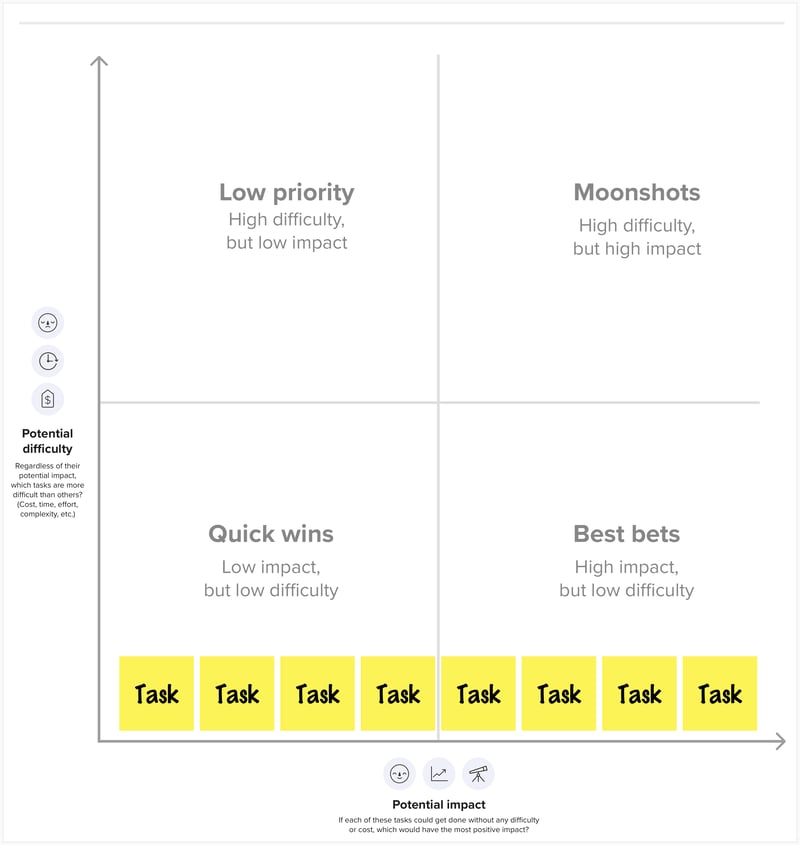
Getting Thoughtful Critique
In my career, getting positive feedback is easy; getting critique (not criticism) can be very difficult. People often don't want to say something they might consider negative. Failing to give critique is a bad cultural issue at companies, but I've seen it over and over again. A fantastic way to overcome this is to utilize the technique Rose-Thorn-Bud which provides a convenient way to bring ideas of the following types:
- Rose: Positive things
- Thorn: Negative things
- Bud: Things that have potential
With these categories, it's easy for your participants to give you feedback of all types. After the ideas are generated, you discuss them as a group. You'll find that this method works wonders for providing feedback that gets you beyond the fluffy "everything is great" feedback you might typically receive.
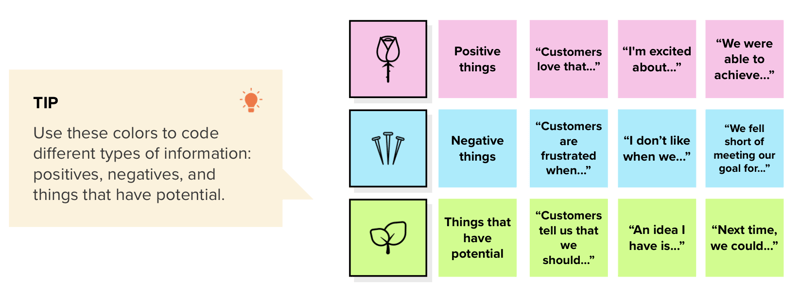
Determining the Usability of Your Solution
So, you've built your latest dashboard, churn prediction utility or amazing forecasting model. How do you get feedback on its usability? We can use common techniques used in product development to evaluate our data science projects no different than any other product. In my team, we do usability studies all the time on our data products and dashboards.
I like to use the first technique Experience Diagramming. This method has a user walk through your tool's journey and then indicate how their experience was along the way. Start with a horizontal line and on the top have positive experiences and at the bottom, negative experiences. Then have the user write down the flow through the tool. Each process step is placed above or below the line, indicating what's working or not from the user's perspective.

If you want a more systematic and repeatable usability test, you can use the System Usability Scale or SUS. SUS is a proven method for determining usability, and it is a simple 10-question survey that asks questions:
- I think that I would like to use this system frequently.
- I found the system unnecessarily complex.
- I thought the system was easy to use.
- I think that I would need the support of a technical person to be able to use this system.
- I found the various functions in this system were well integrated.
- I thought there was too much inconsistency in this system.
- I imagine most people would learn to use this system very quickly.
- I found the system very cumbersome to use.
- I felt very confident using the system.
- I needed to learn many things before getting into this system.
Read more about the System Usability Scale. You can even administer this with digital survey tools like Survey Monkey or Question Pro.
Build a Launch Plan Before You Build
Finally, you're ready to launch your Data Science project. You don't have to wait for all the work to be completed to start thinking about your launch, and you can do it right at the initiation of your product.
The first method is to develop a Concept Poster. This framework makes it simple to think about some of the practicalities of building and launching a solution. In a concept, you fill out the problem you're trying to solve, the key stakeholders, the big idea, the reasons it might fail, how to prototype and test, and finally, how you'll measure success. You also can include an illustration of the idea to drive it home.
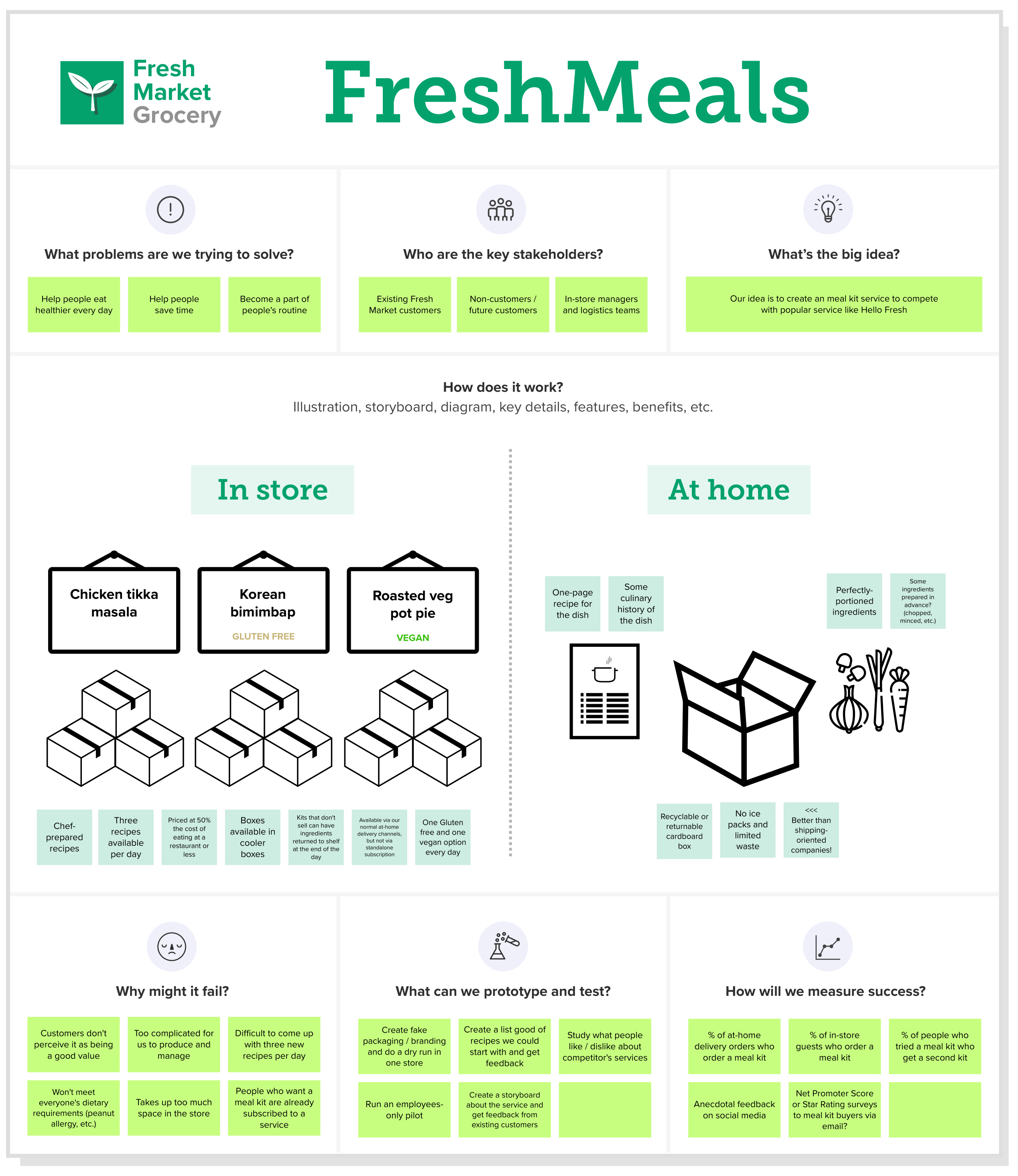
And last but not least is the Cover Story Mockup. This method is similar to writing a press release for your product launch but helps you tell the story about the impact you will make from the project's onset. By creating a cover story or press release, you'll find that the project team members will better understand the customer value you want to create since the story is centered around your customer. Have fun with these. Include details about the value created and even fake customer quotes based on the type of feedback you hope to receive.
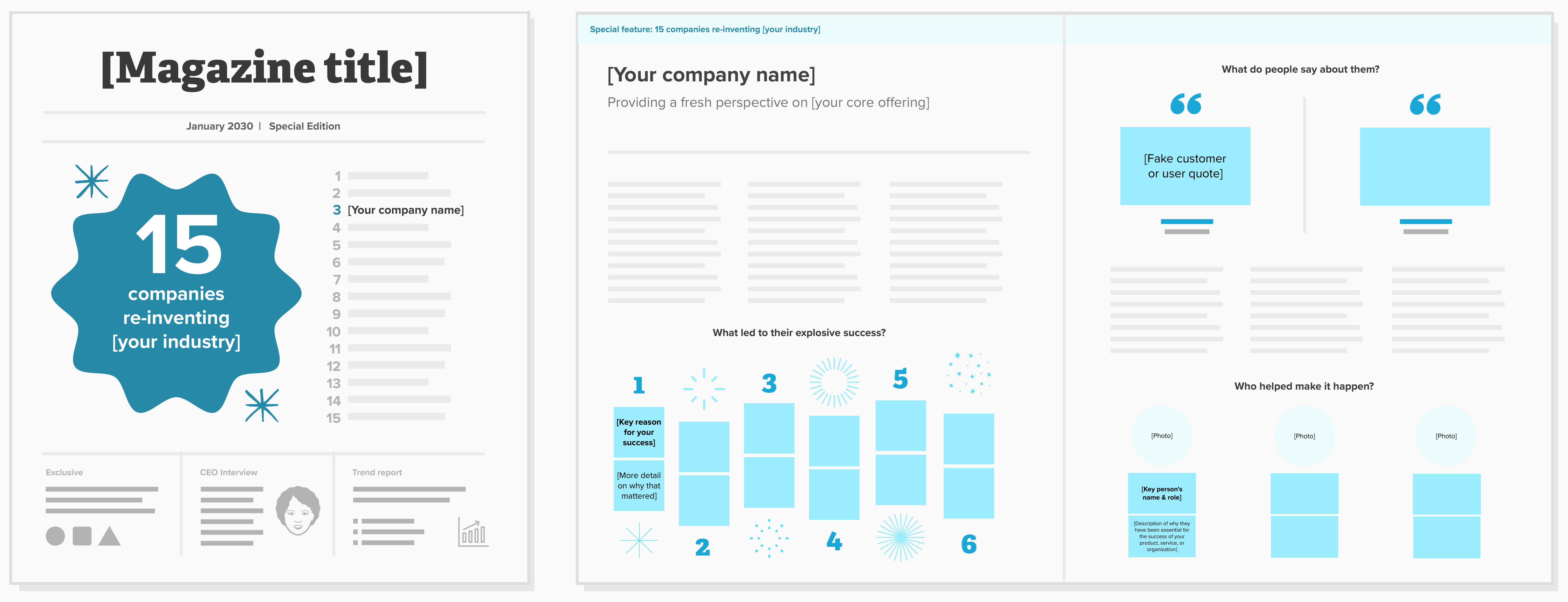
Conclusion
Design thinking is a human-centered approach to innovation. It can bring people together and form new ideas you might not even think were possible before you started. I covered methods to identify and prioritize how you interact with stakeholders on your project—ways to generate a divergent set of ideas and then narrow them down to the most important ones. I covered a couple of ways to prioritize your work by including your stakeholders. When you're ready for feedback, the Rose-Thorn-Bud method was covered as an excellent way to solicit critique. I presented two different methods for determining the usability of your solution that can help you fine-tune what you build. Finally, I shared a couple of ways to think about the launch of your product before it launches. This article is just a high-level overview of how you can incorporate Design Thinking into your Data Science work. I encourage you to learn more and start to leverage one or two techniques!

